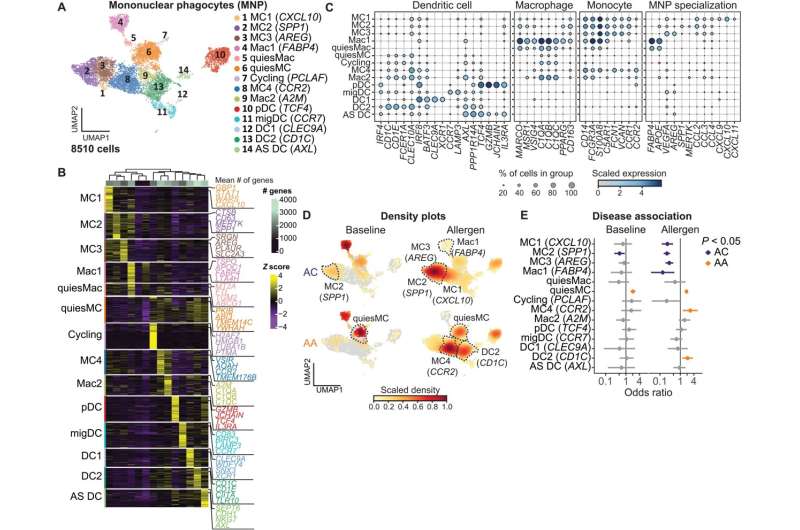This article has been reviewed according to Science X's editorial process and policies. Editors have highlighted the following attributes while ensuring the content's credibility:
fact-checked
peer-reviewed publication
trusted source
proofread
Airways of individuals with asthma found to have higher expression of genes that amplify inflammation

The strongest risk factor for developing asthma is the presence of allergies, but it's unclear why only some individuals with allergies go on to develop asthma.
A team led by investigators at Massachusetts General Hospital (MGH) has identified the key differences in the airway response to allergens between people with allergic asthma and people with allergies but no asthma.
The findings, which are published in Science Immunology, could provide fundamental insights into the mechanisms that underlie asthma.
The study involved what's called a bronchoscopic segmental allergen challenge, whereby a segment of a patient's airway is exposed to allergens.
Before and after allergen exposure, investigators collected samples from the airways of adults who had allergies, with or without asthma.
The team then used single-cell RNA sequencing and protein measurements to determine which cell types, genes and proteins were expressed in the samples they collected.
"By comparing allergic asthmatic participants with allergic non-asthmatic controls, we could identify cellular and molecular pathways that distinguish asthma from allergy alone," says co–lead author Jehan Alladina, MD, a pulmonary physician-scientist at MGH.
Alladina and her colleagues found that, in response to allergens, samples from participants with asthma had higher expression of genes that amplify certain forms of inflammation and promote abnormal structural changes to the airway, whereas participants without asthma had higher expression of genes involved in tissue repair and antioxidant signaling.
The types of immune cells in samples from participants with and without asthma were also different.
"This study identified several cell types and signaling pathways unique to asthmatic patients and could suggest novel targets for asthma therapeutics, particularly those that may break the cycle of chronic inflammation and prevent the structural airway changes that characterize this disease," says Alladina.
"Ultimately, we plan to test therapeutic agents and examine the changes to the response to allergen in allergic patients with and without asthma. These 'proof of concept' studies should hopefully provide a detailed profile of the mechanisms that drive the asthma phenotype."
More information: Jehan Alladina et al, A human model of asthma exacerbation reveals transcriptional programs and cell circuits specific to allergic asthma, Science Immunology (2023). DOI: 10.1126/sciimmunol.abq6352




















